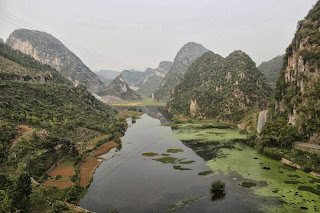On our way to another beautiful scenic area, we passed through a small, rural village near Anshun. It was amazing how "scenic" the town and surrounding rice paddies were. As you can see by the picture below, the town was really concrete buildings along side the one main (paved!) road going through town. It was mainly a farming town, with rice (duh..), corn, and red peppers being the three main crops.
It was also harvesting time, as you can see by the beautiful yellow color the rice has turned out in the paddies. Nearly every paddy had a group of people, both men and women, doing back breaking labor of cutting off the rice stalks, and then beating them against the inside of a wooden box, I assume to get the rice kernels to fall out into the box. In this picture below, the paddy in the middle front has just been harvested. Also, notice how none of the paddies have a uniform shape; instead, they follow the shape of the land, as so much of rice farming depends on water flow. Well, this also means that making the farming process mechanized would be very difficult. Your tractor would have to be no bigger than a lawn mower. This explains why so much of the process is still done by hand. That's my theory, and I'm sticking with it, even though there probably is a lot of mechanization around. These people are just too poor to own it.
Once the rice was threshed(?), the farmers would burn the leftover stalks in piles in the field. It amounted to an amazing amount of small fires than accumulated to a ton to smoke going into the air. When we first got to Guiyang, we were really hoping to find clean air, hoping this area was far enough away from the huge industrial and manufacturing areas of Guangzhou and Shanghai. However, even while we were landing, we could see smog everywhere. Our immediate reaction was "Man, is there any place in China that doesn't have bad air quality?" Still not sure as to the answer to that question. However, after seeing all of the farmers burning the rice stalks, I'm not sure if the smog here is caused from large manufacturing blowing in from elsewhere, or if it is primarily from these fires. The reason why it matters is that maybe when it is not harvest season, Guiyang actually has nice air quality, and we just came at the wrong time for it. Drew created a good analogy for the amount of smoke going into the air. It would be like if every family in Michigan burned a huge pile of leaves in their backyard.
We then saw tons of driveways filled with drying rice, corn kernels, and peppers.
This is an example of how tough of a life these people have. How old do you think this guy is? 80? (Granted, determining the ages of older Chinese people is extremely elusive for me...) And he is still working, walking his horse to the next paddy, so they can load up the horse with the newly threshed rice, then walk it up to the driveways to be laid out to dry. I doubt this guy (nor the horse for that matter) will ever experience retirement from work. Nor will he ever be fat.
Finally, the last thing shown by these pictures is the unique geography present in Guiyang. There were these hills, shaped like gumdrops everywhere, like an image straight out of Dr. Seuss. The hills were amazingly steep, so much so that I think they are unhikeable. I can't understand how these were formed geographically. By plate tectonics? They seem too gum-droppy for that. From glaciers? Maybe....but how would a glacier give the rounded shape? Any ideas?
I remember going to Chinese restaurants when I was a kid. I'd see these types of scroll paintings on the wall and think, "Their mountains are so funny looking! They can't actually look like that in real life..."
Blam. Yes, they do.









No comments:
Post a Comment